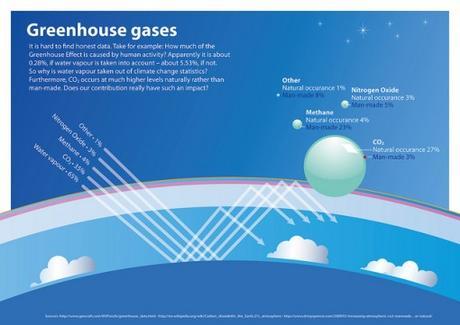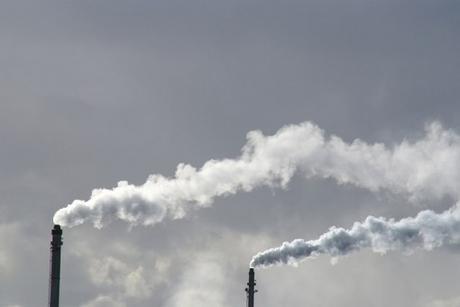What are Greenhouse Gases?
The term ‘greenhouse gases’ (GHG) refers to a type of gas (and there are a few different gases that this can refer to) that is capable to hold or trap heat in the atmosphere. In other words, greenhouse gases are type of gases that first absorbs infrared radiation and then actually emits thermal radiation back. This whole process is basically what causes the greenhouse effect. Without greenhouse effect, this planet would have been much colder and difficult for human race to survive. Increase in the amount of greenhouse gases in the atmosphere results in greenhouse effect, which ultimately leads to global warming.
The planet Earth receives enormous amount of sunlight from sun. Of the total sunlight received, about 30% gets reflected back to the space by clouds, ice, snow, sand and other reflective sources [NASA]. The remaining 70% of the solar radiation is absorbed by the oceans, the land and the atmosphere. This is the reason that earth remains warm even after the sun has gone down as it has absorbed lot of energy from the sun. During night, the Earth’s surface cools down by giving off infrared radiation [EPA]. But before this radiation can emit back into the space, they get absorbed by greenhouse gases in the atmosphere which makes the atmosphere warmer. This is the reason why the earth remains warm which makes it possible for humans to survive.

There are a number of different greenhouse gases, the primary ones of Earth being ozone (the layer that protects us and the rest of the world from the sun’s most harmful radiation), methane, carbon dioxide and even water vapor. With all of these greenhouse gases in the Earth’s atmosphere, the Earth is actually on average approximately 33 degrees centigrade colder than it currently is, rendering most places uninhabitable.
Climate change is a global problem. The planet is warming because of the growing level of greenhouse gas emissions from human activity. If this trend continues, truly catastrophic consequences are likely to ensue from rising sea levels, to reduced water availability, to more heat waves and fires.
-Malcolm Turnbull
What are the Sources of Greenhouse Gases?
As mentioned previously, there are a number of different greenhouse gases in the Earth’s atmosphere. The primary ones are: Ozone, Methane, Water vapor, Carbon dioxide and Nitrous oxide. These all have a number of different sources and some of them are more common than others.
- Ozone (O3)
The ozone layer protects the Earth from the most harmful of the sun’s rays and naturally occurs in the Earth’s atmosphere. The ozone layer occurs between 10 and 50 km above the Earth’s surface. Ozone is actually produced when the ultraviolet waves of the sun come into contact with oxygen molecules.
- Methane (CH4)
Methane is often used as a fuel nowadays, and is most commonly used for heating and for cooking in homes. It occurs naturally in the Earth’s atmosphere and has also been created underground by the decomposition of organic materials over hundreds of millions of years. It is one of the most commonly used fossil fuels and in recent years we have been burning more and more of it which has caused more and more of it to be pumped into the atmosphere as a greenhouse gas.
Additionally, and rather more comically, perhaps, methane is the main gas that is expelled from animals’ bodies when they fart. Unfortunately, because we now have so many cows on Earth for farming purposes, they are actually starting to seriously contribute to the level of methane in the atmosphere, which is contributing to global warming quite significantly.
- Water Vapor (H2O)
Water vapor is simply the gaseous state of water, and occurs naturally in the Earth’s atmosphere as a part of the water cycle. When water vapor collects as clouds in the sky, ready to rain, it can often lock in the heat because it is a greenhouse gas, which is why sometimes even though it is rainy or gray and the sun cannot be seen, it can still feel warm or muggy.
- Carbon dioxide (CO2)
Perhaps the most famous of all greenhouse gases, carbon dioxide is absolutely essential to life here on Earth. It is the gas that we expel when we breathe out and it is the gas that the trees and plants use as an essential component to photosynthesize.
Although it occurs naturally in the atmosphere, a combination of carbon and two oxygen atoms, the fact that we are burning many hundreds and thousands of tons of fossil fuels every single year is contributing greatly to the amount of carbon in the atmosphere. When fossil fuels such as coal are burned, they release carbon dioxide into the atmosphere.
Although it is perfectly safe in the atmosphere, too much of it is contributing to the amount of greenhouse gases in the atmosphere, causing the average temperature of the Earth’s surface to rise gradually each year. Basically, we are digging up coal, gas and petroleum from the Earth’s crust where it has remained for many millions of years and released that carbon dioxide back into the atmosphere where it is causing problems such as the greenhouse effect.
- Nitrous Oxide (N2O)
Nitrous oxide is more commonly known as ‘laughing gas’ and it is given to patients as a dissociated anesthetic. Once again, it is perfectly natural and is normally in the Earth’s atmosphere, although it constitutes only a very small percentage of the overall volume of gases. Nitrous oxide creates nitric oxide when it reacts with oxygen atoms, and so reacts with the ozone layer, making it one of the main regulators of the stratospheric layer of ozone around the Earth, as well as one of the main naturally occurring ones.

Effects of Greenhouse Gases on Climate Change
Greenhouse gases have had a huge affect on climate change. We have been pouring more and more carbon dioxide and methane into the atmosphere, which means that there are many more greenhouse gases present all around the world. Because these gases allow the thermal radiation of the sun through and then reflect it back onto the surface of the Earth when it naturally rises again, it is causing the average temperature of the Earth’s surface to gradually rise.
- Global Warming
Although the Earth has natural cycles of extreme heat and extreme cold, we are causing an unnaturally quick global warming with our constant burning of fossil fuels. More and more of the thermal radiation that comes to us from the sun millions of miles aware is getting trapped on Earth because of the dense layer of many different greenhouse gases, which means that the average temperature of the Earth is on the rise and not set to stop any time soon. This means that many places are suffering from droughts more often throughout the year and some places are becoming completely inhospitable.
- The Melting of the Polar Ice Caps
As a direct result of the greenhouse gases keeping the heat from the sun close to Earth, the polar ice caps are starting to melt at an alarming rate. Not only is this problematic for the animals that rely on those ice caps for their survival – for instance, seals and polar bears that use them as shelter, places to hunt from and places to raise their young – but it could also mean that the average level of the sea will start to rise alarmingly quickly. When the sea rises too high, it will start to cause some of the lower lying land around the world to start disappearing, meaning that many thousands if not millions of people will be forced to move, or may even die.
- Changing of Climates and Seasons
Global warming is not all about the Earth slowly but surely getting hotter and hotter. In fact, it is a lot more complicated than that. Unfortunately, the accumulation of greenhouse gases in our atmosphere means that the average temperatures are gradually rising and that rain is becoming more and more scarce in some areas of the world, but it does also mean that seasons and climates are becoming more and more sporadic and difficult to predict.
For instance, places that are not usually rainy may start getting more and more rainfall; somewhere that usually does not see snow until deep into the winter may be surprised at snowfall in September, or perhaps even earlier. This is because the warming of the Earth has many knock on effects that are difficult to track but that can cause disruption to the way that seasons and climates usually work.
References:
Overview of Greenhouse Gases – EPA


posted on 13 July at 16:07
We all need to do our bit to protect the enviroment! www.frontiergap.com